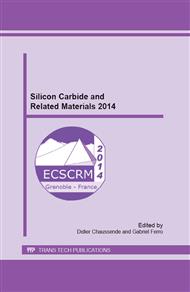p.879
p.884
p.889
p.893
p.897
p.902
p.906
p.910
p.914
Design and Characterization of 500 °C Schmitt Trigger in 4H-SiC
Abstract:
Two versions of Schmitt trigger, an emitter-coupled and an operational amplifier (opamp)-based, are implemented in 4H-SiC bipolar technology and tested up to 500 °C. The former benefits the simplicity, smaller footprint, and fewer number of devices, whereas the latter provides better promise for high temperature applications, thanks to its more stable temperature characteristics. In addition, the measurements in the range 25 °C - 500 °C, shows that the opamp-based version provides negative and positive slew rates of 4.8 V/µs and 8.3 V/µs, ~8 and ~3 times higher than that of the emitter-coupled version, which are 1.7 V/µs and 1 V/µs.
Info:
Periodical:
Pages:
897-901
Citation:
Online since:
June 2015
Authors:
Price:
Сopyright:
© 2015 Trans Tech Publications Ltd. All Rights Reserved
Share:
Citation:


